七年级英语上册Unit7ShoppingIntegratedSkills教案(新版)牛津版
牛津译林版英语七年级上册《Unit 7 Shopping Integrated skills》教学设

牛津译林版英语七年级上册《Unit 7 Shopping Integrated skills》教学设计6一. 教材分析《Unit 7 Shopping Integrated skills》是人教版牛津译林英语七年级上册的一章内容。
本章主要围绕购物主题,培养学生运用英语进行日常交流的能力。
教材通过丰富的情景设置和真实的语言材料,使学生在学习过程中能够理解和运用目标语言,提高他们的语言实际运用能力。
本章包括听力、口语、阅读和写作等各个方面的内容,旨在全面提高学生的英语水平。
二. 学情分析七年级的学生已经掌握了基本的英语语法和词汇知识,具备一定的英语听说读写能力。
但他们在实际运用英语进行交流时,还存在着一定的困难,如词汇量不足、语法运用不准确、口语表达能力较弱等。
因此,在教学过程中,需要针对学生的实际情况,采取有效的教学策略,帮助他们克服这些困难,提高他们的英语水平。
三. 教学目标1.知识目标:让学生掌握本课的生词、短语和句型,了解购物场景下的常用英语表达。
2.能力目标:培养学生运用英语进行购物交流的能力,提高他们的口语表达和听力理解能力。
3.情感目标:激发学生学习英语的兴趣,培养他们积极向上的学习态度。
四. 教学重难点1.重点:本课的生词、短语和句型,以及购物场景下的常用英语表达。
2.难点:正确运用所学的词汇和句型进行购物交流,提高学生的口语表达和听力理解能力。
五. 教学方法1.任务型教学法:通过设定真实的购物场景,让学生在完成任务的过程中,运用所学知识进行交流,提高他们的实际运用能力。
2.情境教学法:创设购物场景,让学生在具体的情境中,感受和理解英语语言的表达。
3.交际法:鼓励学生积极参与课堂交流,提高他们的口语表达和听力理解能力。
六. 教学准备1.教材:人教版牛津译林英语七年级上册《Unit 7 Shopping Integrated skills》。
2.多媒体教学设备:用于展示图片、视频等教学资源。
牛津译林版七年级上册Unit 7 Shopping Integrated skills导学案(含答案
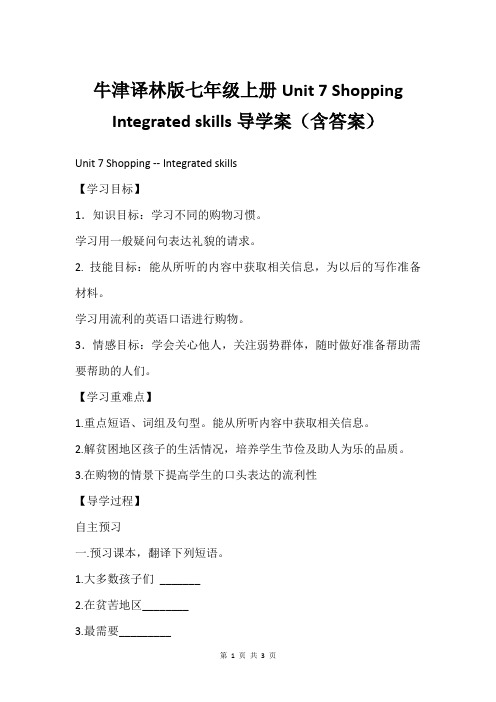
牛津译林版七年级上册Unit 7 ShoppingIntegrated skills导学案(含答案)Unit 7 Shopping -- Integrated skills【学习目标】1.知识目标:学习不同的购物习惯。
学习用一般疑问句表达礼貌的请求。
2. 技能目标:能从所听的内容中获取相关信息,为以后的写作准备材料。
学习用流利的英语口语进行购物。
3.情感目标:学会关心他人,关注弱势群体,随时做好准备帮助需要帮助的人们。
【学习重难点】1.重点短语、词组及句型。
能从所听内容中获取相关信息。
2.解贫困地区孩子的生活情况,培养学生节俭及助人为乐的品质。
3.在购物的情景下提高学生的口头表达的流利性【导学过程】自主预习一.预习课本,翻译下列短语。
1.大多数孩子们_______2.在贫苦地区________3.最需要_________4.要走很长时间的路到达学校___________5.一双鞋子__________6.试穿_______二.预习课本integrated skills的内容,完成课本A1,A2,A3题。
合作交流一.小组之间合作,检测预习情况。
二.小组听录音,并且圈出课本里面的重点和难点的句子。
三.预习课本speak up的对话,分角色朗读对话,并表演出来,评出最优组。
四.小组总结本节课的语法知识点。
学习反思___________________________________________________________ ________________课堂检测一. 根据句意,首字母或中文提示完成单词1. A lot of children use their p money to help children in need.2. We would like to help the children in (贫穷的) areas.3. —Mum, the new jeans are too (大) for me.—OK, I’ll change it for you.4. The new kind of computer is too (贵的). I won’t buy it.5. I’d like to buy a (双) of shoes.二. 所给词的适当形式完成下列句子:1. The sweater ______ ( fit ) very well.2. I like ______ ( watch) TV after ______ (do) my homework.3. He really doesn’t know what ______ (do) next.4. Would you like ______ (donate) some money to the children in Yushu.5. How much is this _______ (双)of sports shoes6. The jeans don’t ________ (合身)me well. I don’t want to buy it..参考答案:一.1.pocket 2.poor 3.big 4.expensive 5.pair二.1.fits 2.watching, doing 3.to do 4.to donate 5.pair 6.fit PAGE。
七年级英语上册《Unit 7 Going shopping Integrated skills》教案
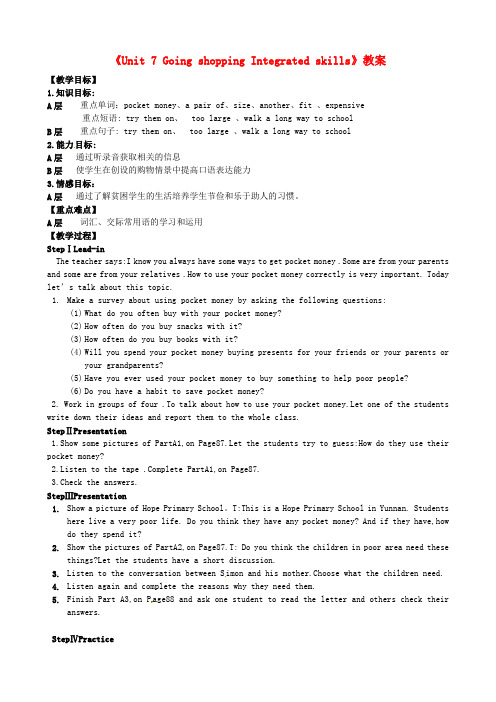
《Unit 7 Going shopping Integrated skills》教案【教学目标】1.知识目标:A层重点单词:pocket money、a pair of、size、another、fit 、expensive重点短语: try them on、 too large 、walk a long way to schoolB层重点句子: try them on、 too large 、walk a long way to school2.能力目标:A层通过听录音获取相关的信息B层使学生在创设的购物情景中提高口语表达能力3.情感目标:A层通过了解贫困学生的生活培养学生节俭和乐于助人的习惯。
【重点难点】A层词汇、交际常用语的学习和运用【教学过程】StepⅠLead-inThe teacher says:I know you always have some ways to get pocket money .Some are from your parents and some are from your relatives .How to use your pocket money correctly is very important. Today let’s talk about this topic.1.Make a survey about using pocket money by asking the following questions:(1)What do you often buy with your pocket money?(2)How often do you buy snacks with it?(3)How often do you buy books with it?(4)Will you spend your pocket money buying presents for your friends or your parents oryour grandparents?(5)Have you ever used your pocket money to buy something to help poor people?(6)Do you have a habit to save pocket money?2. Work in groups of four .To talk about how to use your pocket money.Let one of the students write down their ideas and report them to the whole class.StepⅡPresentation1.Show some pictures of PartA1,on Page87.Let the students try to guess:How do they use their pocket money?2.Listen to the tape .Complete PartA1,on Page87.3.Check the answers.StepⅢPresentation1.Show a picture of Hope Primary School。
七年级英语上册Unit7ShoppingIntegratedSkills教案(新版)牛津版
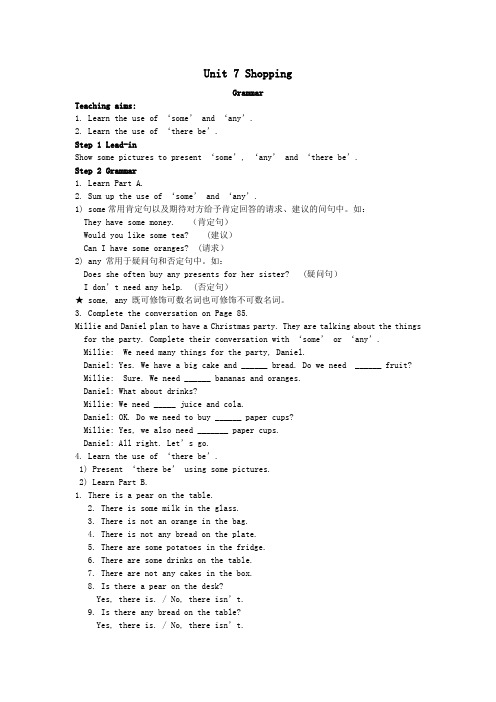
Unit 7 ShoppingGrammarTeaching aims:1. Learn the use of ‘some’ and ‘any’.2. Learn the use of ‘there be’.Step 1 Lead-inShow some pictures to present ‘some’, ‘any’ and ‘there be’.Step 2 Grammar1. Learn Part A.2. Sum up the use of ‘some’ and ‘any’.1) some常用肯定句以及期待对方给予肯定回答的请求、建议的问句中。
如:They have some money. (肯定句)Would you like some tea? (建议)Can I have some oranges? (请求)2) any 常用于疑问句和否定句中。
如:Does she often buy any presents for her sister? (疑问句)I don’t need any help. (否定句)★ some, any 既可修饰可数名词也可修饰不可数名词。
3. Complete the conversation on Page 85.Millie and Daniel plan to have a Christmas party. They are talking about the things for the party. Complete their conversation wi th ‘some’ or ‘any’.Millie: We need many things for the party, Daniel.Daniel: Yes. We have a big cake and ______ bread. Do we need ______ fruit? Millie: Sure. We need ______ bananas and oranges.Daniel: What about drinks?Millie: We need _____ juice and cola.Daniel: OK. Do we need to buy ______ paper cups?Millie: Yes, we also need _______ paper cups.Daniel: All right. Let’s go.4. Learn the use of ‘there be’.1) Present ‘there be’ using some pictures.2) Learn Part B.1. There is a pear on the table.2. There is some milk in the glass.3. There is not an orange in the bag.4. There is not any bread on the plate.5. There are some potatoes in the fridge.6. There are some drinks on the table.7. There are not any cakes in the box.8. Is there a pear on the desk?Yes, there is. / No, there isn’t.9. Is there any bread on the table?Yes, there is. / No, there isn’t.10. Are there any vegetables in the basket?Yes, there are. / No, there aren’t.5. Sum up the use of ‘there be’.1) There be 表示“某地有某物或有某人。
牛津译林版英语七年级上Unit7Integratedskills教学设计(英语教案)

牛津译林版英语七年级上Unit7Integratedskills教学设计(英语教案)Unit 7 ShoppingPeriod 5 Integrated skillsa conversation about shopping;a conversation about shopping;a conversation about shopping;教学过程Speak up: What’s your size?Step 1 Lead-in1. Enjoy the shopping song.T: Good morning, boys and girls. Before the class, let’s enjoya shopping song.2. Review the names of s hops.T: There are many different shops around us. What shops do you know? I have some pictures here. Please tell me the name of ea ch shop.【教学目的:通过视频导入购物话题,设置轻松有趣的课堂氛围。
利用图片复现已学商店名称,并自然过渡到本课话题。
】Step 2 Presentation1. Show students the picture and ask: Where is the lady? What is she doing?2. T: Simon also wants to buy a pair of shoes. He and his mother are talking with the shopkeeper. Listen to thetape and answer the following questions.(1) What size are Simon’s feet?(2) How much does the pair of shoes cost?(3) What does Simon’s mother think of the shoes?3. Ask students to practise reading the conversation and tryto imitate the intonation.【教学目的:呈现书本内容,为随后的对话编写练习提供必要的语言输入。
镇江实验学校七年级英语上册教学案:Unit 7 Integrated skills(无答案)
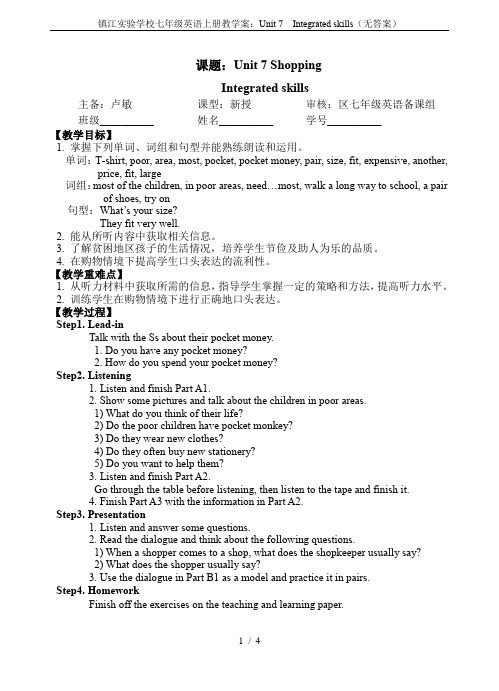
课题:Unit 7 ShoppingIntegrated skills主备:卢敏课型:新授审核:区七年级英语备课组班级__________ 姓名__________ 学号__________【教学目标】1. 掌握下列单词、词组和句型并能熟练朗读和运用。
单词:T-shirt, poor, area, most, pocket, pocket money, pair, size, fit, expensive, another, price, fit, large词组:most of the children, in poor areas, need…most, walk a long way to school, a pair of shoes, try on句型:What’s your size?They fit very well.2. 能从所听内容中获取相关信息。
3. 了解贫困地区孩子的生活情况,培养学生节俭及助人为乐的品质。
4. 在购物情境下提高学生口头表达的流利性。
【教学重难点】1. 从听力材料中获取所需的信息,指导学生掌握一定的策略和方法,提高听力水平。
2. 训练学生在购物情境下进行正确地口头表达。
【教学过程】Step1. Lead-inTalk with the Ss about their pocket money.1. Do you have any pocket money?2. How do you spend your pocket money?Step2. Listening1. Listen and finish Part A1.2. Show some pictures and talk about the children in poor areas.1) What do you think of their life?2) Do the poor children have pocket monkey?3) Do they wear new clothes?4) Do they often buy new stationery?5) Do you want to help them?3. Listen and finish Part A2.Go through the table before listening, then listen to the tape and finish it.4. Finish Part A3 with the information in Part A2.Step3. Presentation1. Listen and answer some questions.2. Read the dialogue and think about the following questions.1) When a shopper comes to a shop, what does the shopkeeper usually say?2) What does the shopper usually say?3. Use the dialogue in Part B1 as a model and practice it in pairs.Step4. HomeworkFinish off the exercises on the teaching and learning paper.【语法小贴士】1. We can use our pocket money to buy them these things.(1)use是动词,use sth. to do,意为“用某物做某事”,通常指使用工具。
牛津译林版英语七年级上册《Unit7ShoppingIntegratedskills》说课稿6
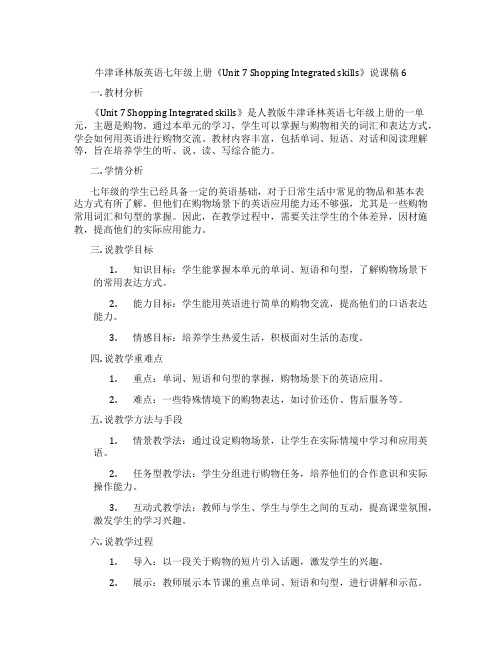
牛津译林版英语七年级上册《Unit 7 Shopping Integrated skills》说课稿6一. 教材分析《Unit 7 Shopping Integrated skills》是人教版牛津译林英语七年级上册的一单元,主题是购物。
通过本单元的学习,学生可以掌握与购物相关的词汇和表达方式,学会如何用英语进行购物交流。
教材内容丰富,包括单词、短语、对话和阅读理解等,旨在培养学生的听、说、读、写综合能力。
二. 学情分析七年级的学生已经具备一定的英语基础,对于日常生活中常见的物品和基本表达方式有所了解。
但他们在购物场景下的英语应用能力还不够强,尤其是一些购物常用词汇和句型的掌握。
因此,在教学过程中,需要关注学生的个体差异,因材施教,提高他们的实际应用能力。
三. 说教学目标1.知识目标:学生能掌握本单元的单词、短语和句型,了解购物场景下的常用表达方式。
2.能力目标:学生能用英语进行简单的购物交流,提高他们的口语表达能力。
3.情感目标:培养学生热爱生活,积极面对生活的态度。
四. 说教学重难点1.重点:单词、短语和句型的掌握,购物场景下的英语应用。
2.难点:一些特殊情境下的购物表达,如讨价还价、售后服务等。
五. 说教学方法与手段1.情景教学法:通过设定购物场景,让学生在实际情境中学习和应用英语。
2.任务型教学法:学生分组进行购物任务,培养他们的合作意识和实际操作能力。
3.互动式教学法:教师与学生、学生与学生之间的互动,提高课堂氛围,激发学生的学习兴趣。
六. 说教学过程1.导入:以一段关于购物的短片引入话题,激发学生的兴趣。
2.展示:教师展示本节课的重点单词、短语和句型,进行讲解和示范。
3.实践:学生进行角色扮演,模拟购物场景,运用所学知识进行实际操作。
4.巩固:通过小组讨论、游戏等活动,让学生进一步巩固所学内容。
5.拓展:教师提供一些购物场景的图片或句子,让学生进行翻译或表达。
6.总结:教师对本节课的内容进行总结,强调重点和难点。
七年级英语上册《Unit7shoppingIntegratedskills》教案牛津版.doc
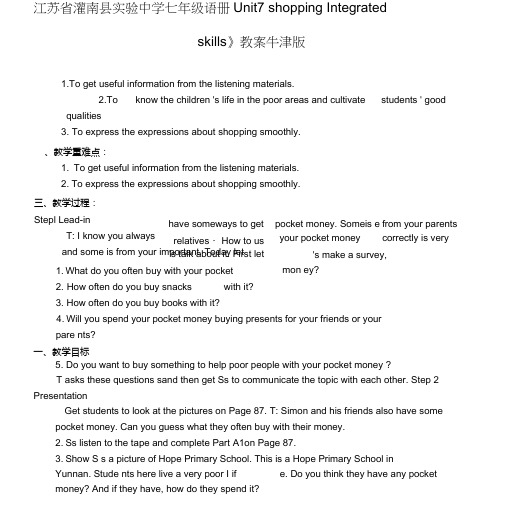
江苏省灌南县实验中学七年级语册Unit7 shopping Integratedskills 》教案牛津版一、教学目标5. Do you want to buy something to help poor people with your pocket money ?T asks these questions sand then get Ss to communicate the topic with each other. Step 2 PresentationGet students to look at the pictures on Page 87. T: Simon and his friends also have some pocket money. Can you guess what they often buy with their money.2. Ss listen to the tape and complete Part A1on Page 87.3. Show S s a picture of Hope Primary School. This is a Hope Primary School in Yunnan. Stude nts here live a very poor I ife. Do you think they have any pocket money? And if they have, how do they spend it? have someways to get relatives ・ How to us 's talk about it. First let students ' goodpocket money. Someis e your pocket money's make a survey, mon ey? from your parents correctly is very 1. What do you often buy with your pocket2. How often do you buy snackswith it?3. How often do you buy books with it?4. Will you spend your pocket money buying presents for your friends or yourpare nts?1.To get useful information from the listening materials.2.Toknow the children 's life in the poor areas and cultivate qualities3. To express the expressions about shopping smoothly.、教学重难点: 1. To get useful information from the listening materials.2. To express the expressions about shopping smoothly.三、教学过程:Stepl Lead-inT: I know you always and some is from your important. Today let4. Ss look at the pictures in Part A2.Do you think the children in poor areasneed these things? Simon and his mother are also talking about this topic. Lefs listen to them and choose what the children in poor area need.5. Listen to it again, and comple te the reasons why they need them. Complete Part A3, thencheck the answers・Step3 DiscussionSs discuss in groups how to help the children in poor areas・(1) Save your pocket money and give it to children in poor areas・(2) Buy things they need.(3) Send •…to them.(4) Become friends with them, and write to each other.Step4 PresentationSimon and his mother are in a shop. They are talking to the shopkeeper. Listento the tape and answer the following questions.(1) What would Simon like to buy?(2) What J s Simon 's size?(3) How much do the shoes cost?(4) Do they buy the shoes?Step5 Practice1. Students listen to the tape and repeat.2. Get Ss to find out the difficulties in the dialogues, T explains them.3. Get Ss to practice the dialogues in pairs, then act it out.4.Ss use the in formation in Part B2 to make up their own dialogues in pairs.Ask several pairs to act it out in front of the class・Step 6 HomeworkRemember the words, phrases and sentences in this period・poor2.Write a letter to the headmaster to talk about how to help the children areas.教学反思:。
- 1、下载文档前请自行甄别文档内容的完整性,平台不提供额外的编辑、内容补充、找答案等附加服务。
- 2、"仅部分预览"的文档,不可在线预览部分如存在完整性等问题,可反馈申请退款(可完整预览的文档不适用该条件!)。
- 3、如文档侵犯您的权益,请联系客服反馈,我们会尽快为您处理(人工客服工作时间:9:00-18:30)。
七年级英语上册Unit7ShoppingIntegratedSkills教案(新版)
牛津版
Grammar
Teaching aims:
1. Learn the use of ‘some’ and ‘any’.
2. Learn the use of ‘there be’.
Step 1 Lead-in
Show some pictures to present ‘some’, ‘any’ and ‘there be’.
Step 2 Grammar
1. Learn Part A.
2. Sum up the use of ‘some’ and ‘any’.
1) some常用肯定句以及期待对方给予肯定回答的请求、建议的问句中。
如:
They have some money. (肯定句)
Would you like some tea? (建议)
Can I have some oranges? (请求)
2) any 常用于疑问句和否定句中。
如:
Does she often buy any presents for her sister? (疑问句)
I don’t need an y help. (否定句)
★ some, any 既可修饰可数名词也可修饰不可数名词。
3. Complete the conversation on Page 85.
Millie and Daniel plan to have a Christmas party. They are talking about the things for the party. Complete their conversation with ‘some’ or ‘any’.
Millie: We need many things for the party, Daniel.
Daniel: Yes. We have a big cake and ______ bread. Do we need ______ fruit? Millie: Sure. We need ______ bananas and oranges.
Daniel: What about drinks?
Millie: We need _____ juice and cola.
Daniel: OK. Do we need to buy ______ paper cups?
Millie: Yes, we also need _______ paper cups.
Daniel: All right. Let’s go.
4. Learn the use of ‘there be’.
1) Present ‘there be’ using some pictures.
2) Learn Part B.
1. There is a pear on the table.
2. There is some milk in the glass.
3. There is not an orange in the bag.
4. There is not any bread on the plate.
5. There are some potatoes in the fridge.
6. There are some drinks on the table.
7. There are not any cakes in the box.
8. Is there a pear on the desk?
Yes, there is. / No, the re isn’t.
9. Is there any bread on the table?
Yes, there is. / No, there isn’t.
10. Are there any vegetables in the basket?
Yes, there are. / No, there aren’t.
5. Sum up the use of ‘there be’.
1) There be 表示“某地有某物或有某人。
There is a chair in the room.
房间里有一张椅子。
There are a lot of students in the playground.
操场上有许多学生。
There aren’t any flowers on the table.
桌上没有花。
Is there any bread in the bag?
2) There be 结构中 be 用法如下:
There is + 可数名词单数或不或数名词.
There are + 可数名词复数.
3) There be 结构的否定句是在be后面加not,即:
There is not / isn’t any computer in my study.
一般疑问句的构成是将动词be移到句首,其他部分的语序保持不变。
其肯定的简略回答为:Yes, there is / are. 其否定的简略回答为:No, there is / are not. is not可缩写为isn’t,are not可缩写为aren’t。
e.g. —Is there a library in your school?
—Yes, there is. / No, there isn’t.
—Are there any new toys in this shop?
—Yes, there are. / No, there aren’t.
4) there be 表示“存在”的状态,即:某处有……,而have则表示“拥有” ,即:某人或某物拥有……
There is a picture on the wall. 墙上有幅画。
I have some pictures. 我有一些画。
6. Complete the exercises in Part B.
Millie is writing about shops around her school. Help her complete her article with the correct forms of there be.
My school is very beautiful, and ________ some shops around it. _________ a bookshop near my school. _________ a lot of good books in it. _________ also some pens, rubbers and exercise books.
Sometimes we go there after school. __________ hair clips, music boxes and some other nice things too. We can buy presents for our friends in the shop. Not far away from my school, ________ also a supermarket. It is not very big, but _________ enough snacks in it.
Step 3 Task
Look at your classroom and make sentences using ‘There is / are…’
Step 4 Exercises
I. 用some, any 填空:
1. Is there _______ paper on your desk?
2. He doesn’t have _______ brothers.
3. We need _______ fruit at the party.
4. Does she have ______ friends there?
5. Would you like _______ bread?
6. There aren’t ________ pears in the basket.
7. Could I have ________ snacks now?
II. 翻译下面句子:
1. 沿着这条街有两家超市。
2. 我能为你做点什么?
3. 我想买一些不同于埃米的礼物。
4. 这条河里有鱼吗?
5. 桌上没有任何蔬菜。
6. 书房里有一张书桌和两张椅子。
Step 5 Homework
Review the use of ‘some’ and ‘any’ and ‘there be’.。
